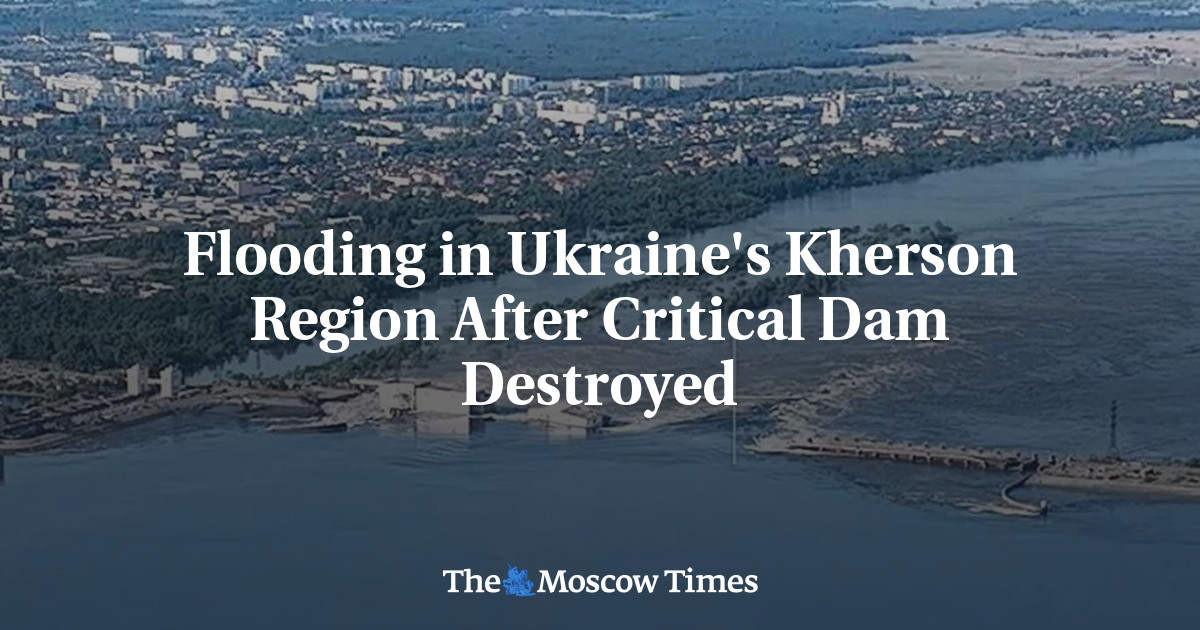
A Russian-controlled dam near the frontline that supplies southern Ukraine and annexed Crimea with drinking water was significantly damaged early Tuesday, prompting evacuations of 17,000 people and threatening the nearby nuclear power plant.
Drone footage originally published by pro-Russian and pro-Ukrainian bloggers showed the broken Kakhovka dam with water flowing freely downstream.
The 30-meter-tall, 3.2-kilometer-long Kakhovka dam, which holds back a massive reservoir on the Dnipro River and is part of a hydroelectric plant, has been a site of ongoing tension throughout Russia’s 15-month invasion of Ukraine.
Ukrainian President Volodymyr Zelensky said the “world must react” to the Kakhovka dam attack, blaming Russia for the breach which has caused extensive flooding.
“The world must react,” he said on social media, adding that Russia had carried out “an internal explosion of the structures” of the plant at 2:50 a.m. local time.
“This is just one Russian act of terrorism. This is just one Russian war crime,” he added, accusing Russia of committing an act of “ecocide.”
“Russia is at war with life, with nature, with civilization,” he added. “Russia must leave Ukrainian land and must be held fully accountable for its terror.”
The Kremlin meanwhile accused Ukraine of “deliberate sabotage” in the Kakhovka dam collapse. Spokesman Dmitry Peskov claimed the Ukrainian forces damaged the dam after allegedly suffering early losses in their counteroffensive launched 48 hours ago.
Peskov also warned that the damage could have “very serious consequences for tens of thousands of residents, environmental consequences and consequences of a different nature that are yet to be established.”
“The Kyiv regime should bear all the responsibility for all the consequences,” Peskov told reporters.
The UN’s nuclear watchdog said that it saw “no immediate nuclear safety risk” at the Zaporizhzhia nuclear power plant, Europe’s largest.
The dam sits on the Dnipro River, which provides cooling water for the plant.
“The IAEA is aware of reports of damage at Ukraine’s Kakhovka dam; IAEA experts at Zaporizhzhia Nuclear Power Plant are closely monitoring the situation; no immediate nuclear safety risk at plant,” the International Atomic Energy Agency (IAEA) said in a tweet.
Andrei Alexeyenko, head of the local government in the Russian-occupied part of the Kherson region, said there was “no threat” to major population centers but added that more than 22,000 people were at risk.
“The increase of the water level downstream from the hydroelectric power station is between two and four meters which is no threat to major population centers,” he said.
Vladimir Leontyev, the Russian-installed mayor of the town of Nova Kakhovka where the dam is located, said residents of “around 300 homes” had been evacuated.
“We are proceeding with the evacuation,” he was quoted by Russian news agencies as saying.
He said Ukrainian forces, which Russia has accused of striking the Kakhovka dam, were continuing bombardment in the area.
“The town is still being targeted by missile strikes,” Leontyev said.
Water levels have reached a 30-year high at the Kakhovka reservoir in recent months, according to satellite measurements.
Experts told The New York Times in May it appeared that Russian forces allowed too much water to enter the reservoir during winter snowmelt and spring rains.
Military bloggers were divided over the flooding’s implications for Ukrainian forces’ anticipated counteroffensive to reclaim territories captured by Russia during its 15-month invasion.
AFP contributed reporting.